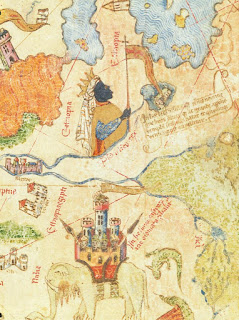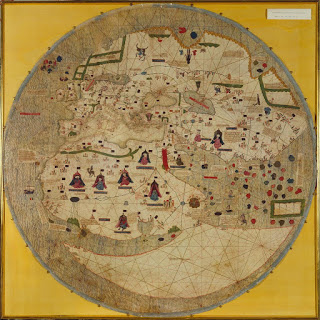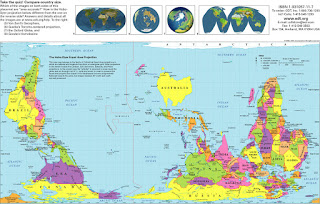Medieval History
- Archaeologists Strike Gold In Quest To Find Queen Of Sheba's Wealth
A British excavation has struck archaeological gold with a discovery that may solve the mystery of where the Queen of Sheba of biblical legend derived her fabled treasures. Almost 3,000 years ago, the ruler of Sheba, which spanned modern-day Ethiopia...
- Being A Scholar And Doing It Anyway.
Hello, readers. How are you? I had intended to start this blog post in the fashion that I have begun most blog posts here to date: with an apology for my long absence and excuses for not posting more. And to date, I have had more or less valid...
- Beauty, Fantasy, Difference
Bosch, Epiphany, 1500, the PradoThere are more papers, more events, more bureaucracies, more of everything that needs to be swept away for just a few minutes. Balthasar has been on my mind since Tuesday, when we entered the third theoretical framework...
- Romance Geographies And Geographic Literacies: Theoretical And Practical Concerns In Mapping Medieval Texts [roundtable]
Kalamazoo 2016 #Kzoo2016 Romance Geographies and Geographic Literacies: Theoretical and Practical Concerns in Mapping Medieval Texts [Roundtable] 51st International Congress in Medieval Studies, Kalamazoo, Michigan (May 12-15, 2016) Organizer: John A....
- Greenwood Hare Chasuble At St John Epping
There are some lovely photos on Flickr of a recently restored chasuble at St John's Epping in Essex. A wonderful vestment blending Gothic and Renaissance motifs, it was designed by Cecil Greenwood Hare, Bodley's chief assistant and...
Medieval History
Questing for Prester John in Ethiopia
 |
| Prester John in Ethiopia, Genoese Planisphere, 1457 |
How quickly the map obsession sets in. Tomorrow is our big day with Prester John, and I will have the total thrill of sharing it in a class session to be attended by a Really Big Medievalist who is coming to campus through the invitation of a good friend of his who is one of the coolest and nicest people I know here. Where we began with Prester John's 12th century letter, when he still "just" ruled the Three Indias, tomorrow, we'll end with the 1520 transcription of his letter to the King of Portugal by Francesco Alvarez, author of The Prester John of the Indies, ambassador and missionary of the King of Portugal, who spent several years at the court of Lebna Dengel in Ethiopia and wrote of him as Prester John. Just mapped all that Prester John goodness right on. There are two massive intertwinings here. The first is history and fantasy. The fantasy of Prester John, the endless quest of Europeans for this imaginary Christian king is endlessly fascinating. The history, though, as it can be imagined to fulfill this fantasy, is captivating, too. Particularly the ancestry of Ethiopian kings from Menilek, the child of Solomon and the Queen of Sheba.
 |
| Catalan Map, 1450 - Prester John's in blue |
The second intertwining is with reading travel writing and finding placenames. I should just let all of the placenames wash over me, some wondrous Uebelian list of marvels. But I find myself wanting to find the place names of the maps, both medieval and modern. In case you're wondering, the medieval maps are harder. Aside from having to sidestep the occasional giraffe or Blemmyae, the placenames themselves are completely different. Googlemaps makes searching modern maps a total thrill. There are intelligent things to say about the globalizing perspective that GoogleMaps offers the armchair traveler, but I don't have them in my head (I bet that Mandeville would have loved GoogeMaps, though). But there are maps....
 |
| Hobo-Dyer Equal Area Projection Map |
.... and there are maps. Wo-ha, right? This is the Hobo-Dyer Equal Area Projection Map, cousin of the famed Peters Projection Map which turned the Mercator Projection Map (the one we're more familiar with) literally on its head. The best (I swear) tutorial on this comes from a 3 and a half minute clip of the West Wing (no, really). There's more to learn, of course. For now, Holly the cat's extreme hounding prompts me to stop, but just so you know, it's even harder to get to Ethiopia let alone India on this map.
- Archaeologists Strike Gold In Quest To Find Queen Of Sheba's Wealth
A British excavation has struck archaeological gold with a discovery that may solve the mystery of where the Queen of Sheba of biblical legend derived her fabled treasures. Almost 3,000 years ago, the ruler of Sheba, which spanned modern-day Ethiopia...
- Being A Scholar And Doing It Anyway.
Hello, readers. How are you? I had intended to start this blog post in the fashion that I have begun most blog posts here to date: with an apology for my long absence and excuses for not posting more. And to date, I have had more or less valid...
- Beauty, Fantasy, Difference
Bosch, Epiphany, 1500, the PradoThere are more papers, more events, more bureaucracies, more of everything that needs to be swept away for just a few minutes. Balthasar has been on my mind since Tuesday, when we entered the third theoretical framework...
- Romance Geographies And Geographic Literacies: Theoretical And Practical Concerns In Mapping Medieval Texts [roundtable]
Kalamazoo 2016 #Kzoo2016 Romance Geographies and Geographic Literacies: Theoretical and Practical Concerns in Mapping Medieval Texts [Roundtable] 51st International Congress in Medieval Studies, Kalamazoo, Michigan (May 12-15, 2016) Organizer: John A....
- Greenwood Hare Chasuble At St John Epping
There are some lovely photos on Flickr of a recently restored chasuble at St John's Epping in Essex. A wonderful vestment blending Gothic and Renaissance motifs, it was designed by Cecil Greenwood Hare, Bodley's chief assistant and...
